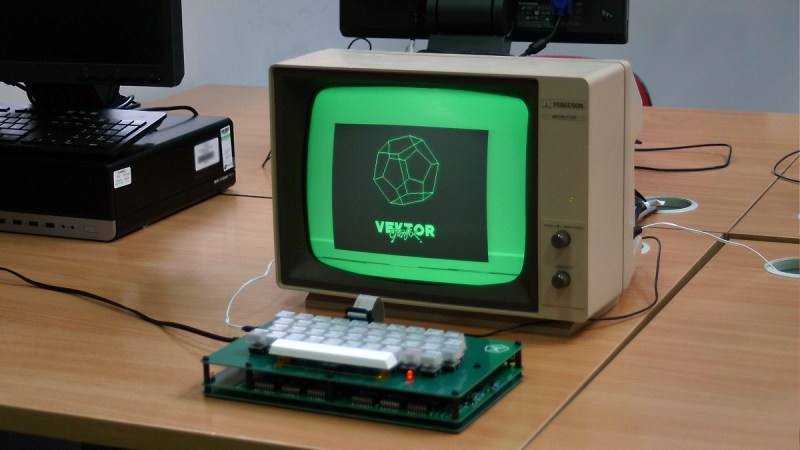If you’ve ever fancied building a ZX Spectrum clone without hunting down ancient ULAs or soldering your way through 60+ chips, [Alex J. Lowry] has just dropped an exciting build. He has recreated the Leningrad-1, a Soviet-built Spectrum clone from 1988, with a refreshingly low component count: 44 off-the-shelf ICs, as he wrote us. That’s less than many modern clones like the Superfo Harlequin, yet without resorting to programmable logic. All schematics, Gerbers, and KiCad files are open-source, listed at the bottom of [Alex]’ build log.
The original Leningrad-1 was designed by Sergey Zonov during the late Soviet era, when cloning Western tech was less about piracy and more about survival. Zonov’s design nailed a sweet spot between affordability and usability, with enough compatibility to run 90-95% of Spectrum software. [Alex]’ replica preserves that spirit, with a few 21st-century tweaks for builders: silkscreened component values, clever PCB stacking with nylon standoffs, and a DIY-friendly mechanical keyboard hack using transparent keycaps.
While Revision 0 still has some quirks – no SCART color output yet, occasional flickering borders with AY sound – [Alex] is planning for further improvements. Inspired to build your own? Read [Alex]’ full project log here.
















Back in early 90s it was my main source of income, building ZX clones for sale. Including Leningrad clone. I still have one bare PCB. Maybe one day I will find some time to make one more. I have built and sold dozens of them. The best time of soldering components from bare PCB to Boot was 25 minutes.
In Soviet Russia, clone builds you!
“Send in the clone !” – Frau Farbissina (Austin Powers)
Please also check this out: cobrasov[dot]org. This is a Romanian ZX Spectrum clone.
Besides Z80, the 16Kx8 EEPROM and the 8 DRAM chips, the rebuilt Turbo Spectrum has 34 74LSxx digital logic circuits, 20 1N4148 diodes, 45 resistors, 21 capacitors, a PN2222A transistor, the 14 MHz crystal, DE-15 VGA and DE-9 connectors, keyboard connector, expansion connector, 3 audio jacks, 2 small speakers, the reset switch and power jack.
We are still making this clones. Like this one you can find an romanian one http://www.cobrasov.org
I love iron curtain clones, even in the most repressive societies (please keep the political comments clean) creativity flourishes.
Who cares about human rights, dignity, or liberty? Yes, let’s keep it clean and polite, bringing up mass-murder, detention, and torture is just so 20th century…
https://m.youtube.com/watch?v=8rWCYo1UcOQ
here is Konstantin Aigi’s video about building Leningrad 48k clone
My 128K “Pentagon” clone with a 5.25″ floppy drive is still sitting on the shelf in my apartment in Russia. Man, time flies. It has been 36 years.
Having been the proud owner of a Spectrum 48K+ back in the mid 80s, I recently backed the Release 2 ZX Spectrum Next on Kickstarter. It’s a fantastic recreation, with tech specs that – while very mild by 2020s standards – would have blown the mind of1984 me. 2MB RAM? Up to a 28MHz core clock? Practically-instant LOADing and SAVEing to an SD card the size of my fingernail? Being able to pull software down /literally from thin air/ using built-in wireless networking?
It’s not until you gaze at modern technology with 40-year-old expectations that you realize just how far we’ve come.
I still can’t get past the second screen of Manic Miner, mind you.
“It’s not until you gaze at modern technology with 40-year-old expectations that you realize just how far we’ve come.”
Depends on point of view. Back then “building” a PC didn’t mean to plug expansion cards in a mainboard or to install a motherboard in a chassis (assembly) .
It rather meant that you used a soldering iron, schematics and kits to build your computer.
Many users were more than consumers back then,
they had to learn and understand how the computer worked.
Now 40 years forward we have people who are consumers in first place, rather than human beings and autodidacts.
We have lost something, too.
When we want to be sarcastic, we could say that technology has progressed more than we did.
We’re nolonger the masters of our computers (and smartphones in particular), but their slaves.
We can’t fix them anymore, either.
That’s something that has an effect on society, too, I think.
Knowledge and IQ peaked in the 90s, according to some sources.
People have lost universal knowledge in favor of special knowledge of a small field, maybe.
More than often, I wish back for the times of 8088 to 386 mainboards, DOS and Norton Commander.
Back when ordinary users could program their PC in QBasic or debug.com
and fully understand the operating system and hardware on low-level basic.
That’s what many C64 users feel, too.
The direct interaction with a computer, the total control over it.
And the ability to fix it and trouble shooting it.
Anyway, these are just some thoughts.
JFYI
1. https://speccy-info.translate.goog/%D0%9B%D1%8C%D0%B2%D0%BE%D0%B2_(%D0%BA%D0%BE%D0%BC%D0%BF%D1%8C%D1%8E%D1%82%D0%B5%D1%80)?_x_tr_sl=auto&_x_tr_tl=en&_x_tr_hl=en-US&_x_tr_pto=wapp
2. https://www-zxpress-ru.translate.goog/print.php?id=636&_x_tr_sch=http&_x_tr_sl=auto&_x_tr_tl=en&_x_tr_hl=en-US&_x_tr_pto=wapp
I love that green monochrome screen too.